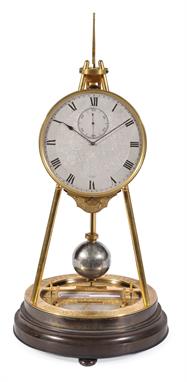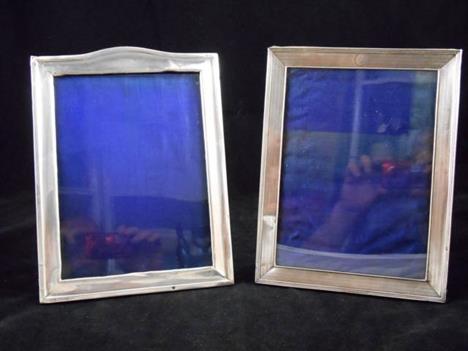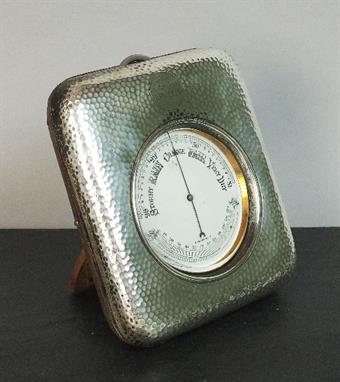We found 30753 price guide item(s) matching your search
There are 30753 lots that match your search criteria. Subscribe now to get instant access to the full price guide service.
Click here to subscribe- List
- Grid
-
30753 item(s)/page
A late 19th Century French pottery and gilt metal novelty table timepiece in the form of an artist`s palette and easel, the rectangular palette painted with a church and cottages in a snow scene, framing a gilt and black painted chapter ring with Roman numerals, printed `B & Cie, Creil et Montereau` to back, resting on a gilt metal easel stand, total height approx 44.5cm.
A PAIR OF EDWARDIAN PHOTOGRAPH FRAMES, maker`s mark HM, Birmingham 1902, of square form, the fascias stamped and pierced with scrolls and diapering centred by a vacant scroll cartouche, on a velvet easel back, 6" square, internal circular aperture 3 1/2" diameter, together with a modern photograph frame, London 1986, in Art Nouveau style with cranes flying above a lily pond, 4 1/4" square (2)
DAVID GAULD RSA (1865 - 1936, Scottish) TWO CALVES IN A BYRE Signed oil on board, 51 x 60cm (20 x 23 1/2") Born in Glasgow, 7 Nov 1865, a Scottish painter, stained-glass designer and illustrator. He attended evening classes at the Glasgow School of Art from 1882 to 1885 while an apprentice lithographer. In 1887 he worked as an illustrator on a Glasgow newspaper and in 1889 provided illustrations for a book of poetry by James Hedderwick. Gauld`s innovations in painting chiefly emerge in his early decorative pictures, rather than the popular, rural Ayrshire paintings he produced from the mid-1890s onwards. He was a good friend of Charles Rennie Mackintosh. His first works to attract public attention were his illustrations in the `Glasgow Weekly Citizen`, which reflected his interest in Japanese prints. These also influenced his easel paintings and designs for stained-glass windows. His largest and most challenging project was a series of stained-glass windows for St Andrew`s Scottish Church in Buenos Aires, manufactured by the Glasgow glass company, Guthrie and Wells
AN EARLY 20TH CENTURY FRENCH GILT BRASS PHOTOGRAPH FRAME, rectangular with a reeded and foliate slip enclosing an aperture 14.5cm x 10cm, surrounded by green silk border mounted with bay leaf sprays and flower clusters, within a gadroon border, backed with green morocco with easel stand, 23cm x 19cm overall. See illustration
AN EDWARD VII SILVER FACED GOLIATH POCKET WATCH STAND, by Abrahams Brothers, Birmingham 1909, of rectangular cushion form, internally lined in green velvet and silk, easel stand, 20.5cm x 16cm, together with a nickel cased goliath pocket watch, marked '8 Days Swiss Made' to the white dial (2)
A fine engraved and patinated brass tripod table clock of month duration with aneroid barometer and mercury thermometer Thomas Cole, London, pre-numbered, circa 1845 The tapered two-tier movement with six-wheel train with five-spoke crossings between spotted plates, the upper section with four pillars retained by blued steel screws to backplate enclosing Vulliamy type deadbeat escapement and train as far as the centre wheel, the conforming deeper lower section containing spring barrel and 2nd wheel and with knurled hand setting screw to backplate, the 5.75 inch circular silvered Roman numeral dial with subsidiary seconds dial and small oval reserve signed THO`s COLE, LONDON to the lower margin of the fine engraved centre decorated with intense scrolling foliage on a hatched ground, with blued steel spade hands within slender moulded glazed bezel applied with foliate engraved shaped pendant cartouche incorporating winding square beneath, the dial and movement assembly resting on two turned supports fitted to the front two uprights of the tripod easel support and secured with knurled fixing screws to rear at top, the frame terminating with a disc applied with surmount cast as a curved bracket for hanging a small plumbline bob at apex and fitted with wide jaw for suspending the steel-alloy bob pendulum with fine screw adjustment to the spherical silvered brass bob beneath, the whole mounted on circular frosted gilt base with glazed demi-lune silvered barometer sector calibrated for barometric inches, with the usual observations and with gilt setting pointer set before an angled mercury Fahrenheit scale thermometer and pendulum beat scale rising to double-up as a pendulum holdfast within recessed field finely engraved with foliate scrollwork, the outer collar with conforming engraved panel infill between the supports incorporating oval repeat signature THO`s COLE, London to leading edge, on patinated brass cavetto moulded skirt base with ledge to take the original glass dome cover and with three screw-adjustable compressed bun feet, the clock 50cm (19.5ins) high; 53.5cm (21ins) high including dome, complete with original engraved gilt brass winding key. The life and work of Thomas Cole is extensively documented in Hawkins, J.B. THOMAS COLE & VICTORIAN CLOCKMAKING. Thomas Cole was born in Nether Stowey, Somerset in 1800. His father, Thomas senior, was a local clockmaker who is now known to have moved his family to Taunton in around 1815; he was a talented maker who probably taught both Thomas and his older brother, James Ferguson, the clockmaking trade. By 1821 James Ferguson had moved to London and filed a Patent for a pivoted detent escapement, by 1823 he was working from New Bond Street where he was joined by his younger brother, Thomas. Over the next twelve years the two brothers worked alongside each other and produced a series of highly complicated silver `humpback` carriage clocks very much in the manner of Abraham Louis Breguet (leading some to speculate a connection between Breguet and the Cole brothers). The brothers then went their separate ways with James Ferguson going on to explore his technical abilities later developing a series of escapement designs including a `resilient` lever escapement (1830), a `double rotary` escapement (1840), a detached escapement calliper (1849) and an escapement with negative diameter (1859). Thomas Cole sought to specialise in small decorative timepieces of the highest quality. By 1845 he was advertising himself as a `designer and maker of ornamental clocks` and in 1851 submitted examples for display at the Great Exhibition, both under his name, and on the stands of other leading retailers such as Hunt & Roskel and Hancocks. He then went on to exhibit at the Paris Exhibition of 1855 where his entry warranted an `Honourable Mention`, and again at the British International Exhibition in 1862 where he was awarded a medal for `Excellence of taste and design`. Thomas Cole was elected to the Royal Society of Arts in June 1861; he died three years later of typhoid fever, at his home at 1 Westbourne Park Road, Paddington, leaving his second wife Charlotte and their three children (two boys and one girl). The originality and inventiveness of design coupled with the exceptional quality of finish ensured an enduring popularity for Thomas Cole`s work, mainly from the rising Nouveau Riche class of Victorians made wealthy from the Industrial Revolution. The current lot belongs to one of four designs of tripod clock produced by Cole from around 1840 to circa 1865. The engraving to the centre of the dial, with its horizontal line hatching, indicates that this timepiece belongs to his earlier phase of production (see Hawkins, THOMAS COLE.. pages 40-1), this coupled with the lack of serial number (numbering commenced circa 1846/7) would suggest a production date of around 1845.
SILVER OVAL TRINKET BOX AND OTHER SILVER OBJECTS the trinket box with hinged lid and on four feet; along with a silver pocket watch travel case/easel stand, silver pill box and Georgian parcel gilt snuff box, and three silver lidded toilet bottles (7) The trinket box hinge is broken and the box has several dents and misshapen feet; the pocket watch stand is dented in several places; snuff box is almost mint condition; pill box undamaged; one of the toilet bottles has a badly dented lid
A Regency rosewood Dressing Case with brass scroll inlay and inset brass handles, the interior with numerous silver lidded jars, bottles and inkwell, plated beaker,ivory box, the lid containing easel mirror and red leather pouch labelled Lawrence, late Elvey, 9 New Bond St, London, drawer beneath, 13 1/2in
A 19TH CENTURY INDIAN CARVED EBONY PICTURE FRAME having a shaped arch crest carved with deities and foliate scrolls^ the uprights carved with conforming scrolls and capped by kneeling children^ the base with scrolling brackets and carving. 53.5cm(h) x 44.5cm(w) Some knocks and scratches^ easel stand missing from reverse with remains of replacement.
AN EARLY 19TH CENTURY CONTINENTAL BIRDS EYE MAPLE MIRROR in the Biedermeier style^ with gilt metal slip and rosettes to each corner all surmounted with gilt metal crest in the form of a religious Crown and flowing banners^ the material lined reverse with easel stand^ bearing the remains of a small label reading` Berlin W`. 48.5cm x 38cm The upper section of beading missing^ the material reverse stained and tacked in place^ easel stand joint appears repaired.
CRYSTAL PALACE - A COLLECTION OF `A PRESENT FROM...` SOUVENIRS, including three small oblong plaques with shell lined printed views and gilt lettered plush lined backs, 4" x 2 3/4", SMALL PURSE, PHOTOGRAPH FRAME with easel support, `PICTURE POST` 35mm ROLL FILM, boxed, CIRCULAR COLOUR PRINT with tin foil back and pierced gilt metal frame, etc (12)
Nine various late 19th/early 20th century photograph albums containing numerous portrait and family group photographs, to include gentlemen, ladies, children, musicians, theatre performers, an artist seated beside an easel, school photographs, regimental figures, etc., together with an empty leather bound album CONDITION REPORTS Contains over 500 photographs, all albums have heavy wear, spines broken, etc. Photographs themselves have general wear conducive with age and storage to include some foxing, discolouration, etc.
-
30753 item(s)/page


























































